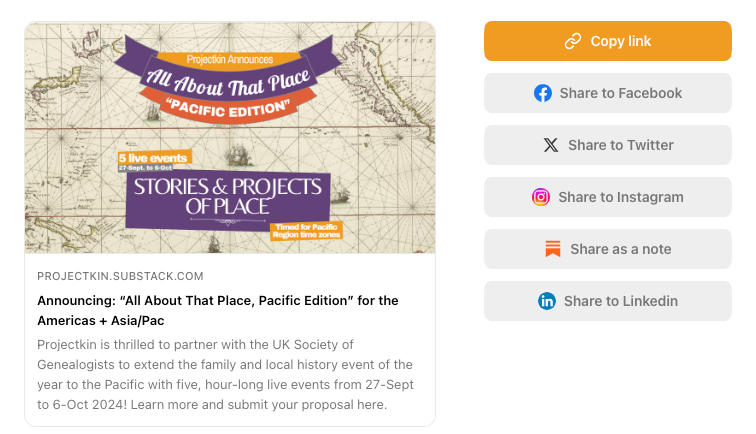Why Substack for a Family History Community?
We're cheerleaders for family history research and storytelling—not for platforms. Here's why we've chosen to build our community on Substack. We want you to understand what we value and why.
Family history is inherently collaborative.
Family historians have been collaborating for millennia. If you have a question about genealogy, you ask a grandparent, cousin, or aunt, right? If you need more details, head to a library and ask a librarian or join a class. Research techniques from one family line can readily be transferred to another, and project ideas for one occasion can inspire variations for another. These factors have made collaboration platforms indispensable to family historians.
Our digital world has created a rich array of platforms where we can find kindred spirits for collaboration. These platforms continuously change, however, as competitive pressures and technological innovations create new opportunities. These changes trigger communities to migrate from one platform to the next as new features are introduced, and a nexus of collaborators moves on. Did you migrate from MySpace to Facebook or Blogger to WordPress? If you’re like most people, you probably did.
It’s happening again.
Today, online Family History communities are witnessing another migration away from X (formerly Twitter), where hashtags like #AncestryHour and #GenChat have brought people together for years. Platform and policy changes, however, are pushing them away. Over on Facebook, things have gotten dusty as group managers discover a lack of control and ownership. There are thousands of genealogy groups, but these days, only a few generate more than a post or two a day.
Substack is shaking things up
Substack entered the online market in 2017 with a new business model. Instead of advertisers, they aligned their interests with writers and creators looking to earn money from their creative work. They uniquely combined blog hosting with email distribution and a payments engine so that creators could write, distribute, and get paid directly for premium content. Instead of charging creators fees for membership software as competitors had, Substack takes a cut when creators accept payments.
It’s that simple.
Substack’s software features serve the primary goal of making its creators successful. It works like a blog or website in that creators own their content — and their email lists. It also works like an online community because a recommendation engine helps like-minded creators find each other. Substack’s incredible scale makes it feasible to support small newsletters even if offered for free.
Since their launch in 2017 they’ve added a boatload of features, most recently doubling down on a competitive opportunity introduced by the troubles at X and other social media platforms. Most notable are the introduction of sophisticated media features for video and audio podcasting, find-follow features that mimic a social media platform, and Notes an comment and content sharing mechanism.
Why we’re here
As Projectkin and GenealogyMatters, we individually brought our community-building efforts to Substack in 2023 based on the promise of this rich feature set. We’ve grown thanks to a powerful recommendation engine and the generosity of a small but growing genealogy community.
Note: Though Substack has many tools for creating and sharing stories, none is explicitly tailored for genealogists. A platform algorithm tailored to topics like History, Politics, and Culture helps new users find each other, but it still lacks a Genealogy topic. We view this as a short-term limitation that will be corrected if we generate enough activity.
That’s where Mission: Genealogy comes in
We felt Substack needed a “Genealogy Commons,” or town square. It would be someplace where we might welcome newcomers and help them navigate the community. As Mission: Genealogy, we’re here to help.
A high-level view of how Substack works
You can participate in a Substack-based community in several ways:
You are a “reader” when you’ve dropped your email address and tapped “subscribe” at any Substack (like MissionGenealogy.Substack.com) As a reader, you simply explore the work of others; it’s like reading an article on a web page, except that it comes to your email inbox too.
You know it’s a digital platform, so you expect to be able to do more. You can.
Once you create a Substack account and validate your identity (usually by tapping a link in an email), you are now a “reader with the ability to comment.” Substack has validated your identity, so you’re allowed to contribute to a conversation with comments. This is comparable to Blogger or WordPress, for example.
Once you have a Substack account, you can also be a “writer” who may contribute to others' publications as a guest. Since Substack makes money when you make money on your own publication, they’re very eager to encourage you to create your publication.
Which takes me to the top level,
Substack’s web and mobile app interfaces will quickly create a substack for you so that you become a “writer with your own Substack newsletter” (also called a “publication” or just “stack.”) Don’t worry if you’ve created a stack.1
Though Substack uses the terms “subscribing” and “following,” they are used differently than in other platforms.
When you subscribe to a Substack newsletter, you will have shared your email address with a publication. By default, you’ll receive every new post via email, you can manage your subscription to subscribe without receiving every post via email, for example.
You may also choose to follow someone so that their posts appear in your online “feed,” but they will not be emailed to you. It’s like “subscribe-lite” because the publication does not capture your email address.
If you’re interested in a newsletter, many, like GenealogyMatters, allow you to support it financially with a paid subscription. When you’re a paying subscriber, they offer special features and added material. Some, like Projectkin, don’t include paid options.
Explore before you subscribe
Substack welcomes new visitors exploring new Substack newsletters with a “welcome” page (Projectkin.Substack.com/welcome for example.) This welcome page encourages visitors to subscribe.
Unless a Substack is private, you can always tap the link named “Let me explore first… >,” “Maybe later” (or similar language) to explore a site before committing to even a free subscription.
Substack’s motives are aligned with those of its writers and publishers. It wants you to explore Substacks widely before committing to subscribing. Substack wants you to find newsletters that truly interest you, subscribe, and upgrade to become a paid subscriber. That works because the platform is not in the advertising business.
Looking at it this way, you realize you don’t have to choose between Substack, MailChimp, or WordPress. You can use those platforms to create your site, newsletter, or platform. If you want to read and participate in the Genealogy community on Substack, come on in and read. You can support a writer as a follower, subscriber, or paid subscriber — or just browse.
It’s not like Facebook, X.com, Instagram, or other social media platforms either. Most of these platforms force you to create an account to view the materials of others on the platform. These platforms do this because they’re in the advertising business. Your email address and profile data define the material they’re selling to advertisers.
Features affect the posts you create
The range of features for posts creates some attractive collaboration options for newsletter publishers:
Rich media features include transcriptions and allow you to share voice and video recordings via email.
The complexity of managing media players compatible with email disappears. A reader taps a button, and the media plays. It’s that simple.
Transcription, usually an expensive add-on, is free with audio and video media posts.
Comments, notifications, and threads are vital to collaboration. Once people start talking to each other in threads, they get to know each other, care about outcomes, and invest more effort.
Commenting works consistently2 across all types of media within Substack.
You’re only allowed a limited number of design options, but there are also very few configuration elements to get wrong.
Sharing and distribution mechanisms make it easy for people outside the platform to explore and engage with the content.
Since Substack is relatively new, they’ve invested heavily in ensuring that posts can easily be shared on other platforms like Facebook, X, Instagram, and LinkedIn.
Privacy options allow you to constrain access to stories you might not want to share with the public.
This feature is primarily used to restrict some content to paid customers. However, you can also use it to restrict some content to select members only. See Projectkin’s “Private Podcast” recipe in September.
As family historians, Substack can be an incredible way to get all the benefits of a blogging platform without exposing family history details to the public.
Figuring it out together.
As Projectkin and GenealogyMatters, we’ve used these features to build out our individual Substack communities. Though we’ve been successful, there are, of course, impediments.
As a platform, Substack’s incentive is to get every “reader” to become a “writer.” They want everyone to charge for premium material, which is entirely rational; it’s how they make money.
Becoming a “writer” can entail more complications than many people want to engage in when they first get started.
That’s okay. This is why we guide people through becoming a “reader” first.
Without hashtags, groups, or even a Genealogy topic, it can be hard for family historians to find each other.
That’s okay; we’ll help each other.
From our perspective, these impediments are mere speedbumps. We have been navigating new technologies since the start of our careers. We know that arriving at a platform early means we have the extra burden of educating others. To get that started, we’re organizing regular Office Hours, a series of programs where we can help each other live. Join us at our monthly sessions starting September 10.
Since the clock slides past time zones around the world, we’ve planned to record topics as needed, creating a customized archive of how-to instruction just for family historians and genealogists using Substack. To jumpstart the effort, we’ll begin with a recording about account types:
Finally, because recommendations give us the most tangible way for us to support each other, we’ve created a fun way to share our best recommendations. Learn more:
“Be” the change you want to see 💪
We also know that getting here early means we can help shape the culture of the community that develops around us. As MissionGenealogy, we’ve rolled up our sleeves and are delighted to welcome you into the effort. Let’s do this together.
We’d love for you to join us.
You can also become part of the movement by attending events, writing guest articles for others, and sharing what we’re doing.
There’s no harm, and it can be useful. Join us for Office Hours, and we’ll show you how to make that Stack private or invitation-only.
Well, mostly consistent. Subtle implementation differences affect how commenting, chat, and notes behave with advanced features like at-notifications and embedding, for example. These are subtle and slowly disappear as development addresses issues.

















Hello Barbara. A 9am timeslot works for me. However 3am isn’t too difficult
I am looking forward to joining you in this Genealogy Mission. I'd also like to say thank you for the overview of how Substack works. I've been blogging on Wordpress for about 12 years and have recently come to Substack,. Your article has answered my questions.